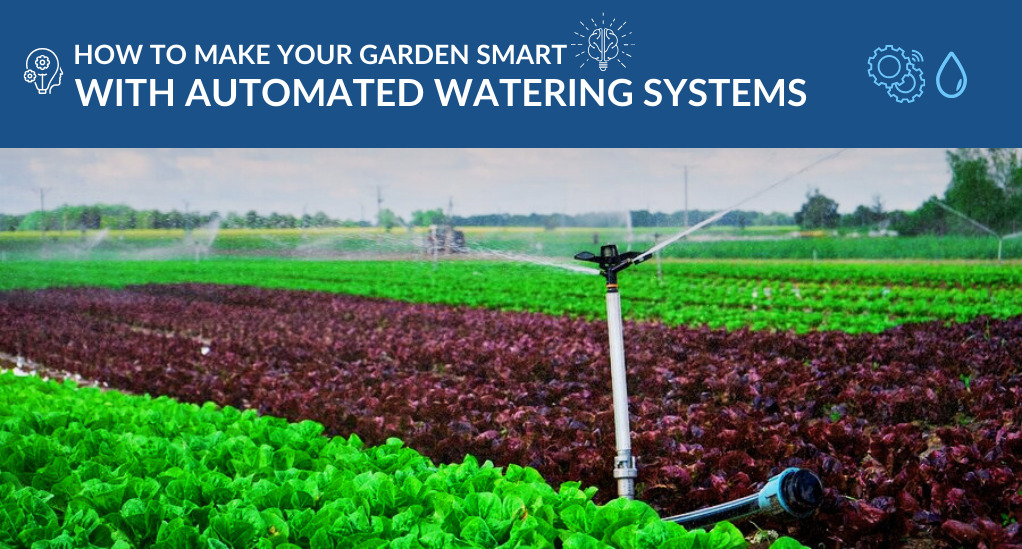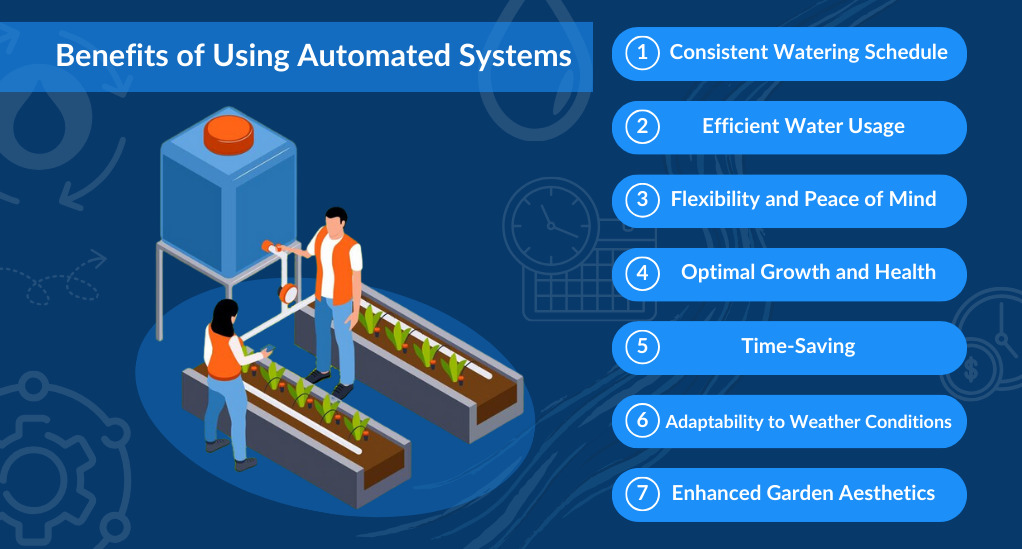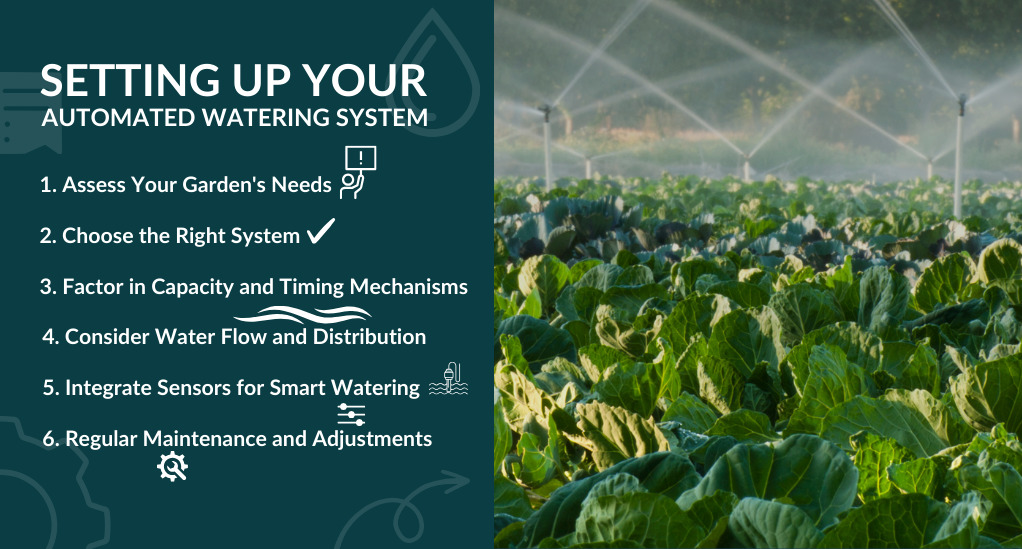
How to Make Your Garden Smart with Automated Watering Systems
Water is the lifeblood of any garden. Whether you’re cultivating a lush backyard oasis or tending to a few potted plants on your balcony, ensuring that your plants receive the right amount of water is crucial for their growth and health. However, with our busy lives, remembering to water the garden consistently can be a challenge. Over-watering can drown the roots, while under-watering can leave your plants parched and struggling. This delicate balance is where the magic of automated watering systems comes into play.
The Importance of Regular Watering for Plant Health
Every plant, from the tiniest succulent to the grandest oak tree, relies on water for its survival. Water plays a pivotal role in various plant processes:
- Photosynthesis: Plants convert carbon dioxide into oxygen using sunlight, and water is a key ingredient in this process.
- Nutrient Uptake: Water helps dissolve nutrients in the soil, making them accessible to the plant’s roots.
- Temperature Regulation: Through a process called transpiration, plants release water vapor, which cools them down, much like how sweating helps regulate our body temperature.
| Plant Type | Water Requirement |
|---|---|
| Succulents | Low |
| Ferns | High |
| Fruit Trees | Moderate to High |
| Grasses | Moderate |
The Challenges of Manual Watering
While the act of watering might seem simple, there are numerous challenges associated with manual watering:
- Inconsistency: It’s easy to forget or skip watering sessions, especially during busy weeks or vacations.
- Over-watering: Without proper knowledge, one might give plants more water than they need, leading to root rot and other diseases.
- Under-watering: On the flip side, not providing enough water can cause plants to wilt and, in extreme cases, die.
- Time-consuming: For larger gardens, manual watering can be a time-intensive task, taking away from other gardening activities.
The Rise of Automated Watering Systems
The concept of automation is not new. For decades, industries have been leveraging technology to streamline processes, reduce human error, and enhance efficiency. The gardening world, too, has embraced this trend, leading to the development of automated watering systems. But what prompted this shift from traditional watering cans and hoses to sophisticated automated setups?
A Brief History of Garden Automation
The origins of garden automation can be traced back to the early 20th century when farmers and large-scale gardeners sought ways to irrigate vast stretches of land without manual intervention. The initial systems were rudimentary, often involving a series of ditches and channels to distribute water. However, as technology advanced, so did the methods:
- 1960s: The introduction of plastic tubing revolutionized irrigation. Drip irrigation systems, which delivered water directly to the plant’s base, became popular, especially in arid regions.
- 1980s: Electronic timers entered the market, allowing gardeners to set watering schedules. This was a game-changer for those who traveled frequently or simply forgot to water their plants.
- 2000s and Beyond: With the advent of smart technology and the Internet of Things (IoT), modern watering systems can now be controlled via smartphones, respond to weather forecasts, and even detect soil moisture levels to water plants precisely when needed.
Why the Need for Automation in Gardening?

Several factors have driven the adoption of automated watering systems:
- Conservation: With increasing concerns about water scarcity, there’s a pressing need to use water judiciously. Automated systems, especially drip irrigation, ensure minimal wastage.
- Urbanization: As more people move to cities, they’re left with limited gardening space, often restricted to balconies or terraces. In such scenarios, precision becomes crucial, and automated systems offer just that.
- Lifestyle: The modern lifestyle is hectic. People travel, work long hours, and juggle numerous responsibilities. Automated watering ensures that their plants thrive, even in their absence.
- Optimal Growth: Different plants have varied watering needs. Automated systems can be tailored to cater to each plant’s unique requirements, ensuring they receive the right amount of water at the right time.
Types of Automated Watering Systems
As gardens have evolved, so have the tools and technologies designed to nurture them. Automated watering systems, in particular, have seen a plethora of innovations, each tailored to cater to specific needs and environments. Let’s delve into the various types of systems available and understand their unique features and benefits.
1. Watering Globes and Spikes
- Description: These are bulb-shaped containers, often made of glass or plastic, that release water into the soil through a narrow stem or spike. They rely on the principle of capillary action, where the soil draws water from the globe as it dries.
- Best For: Small indoor plants or potted plants on patios.
- Pros: Simple to use, decorative, and doesn’t require any power source.
- Cons: Limited water capacity and not suitable for larger plants or gardens.
2. Drip Watering Systems
- Description: This system uses a network of tubes and emitters to deliver water directly to the base of each plant. It’s highly efficient as it minimizes water wastage through evaporation or runoff.
- Best For: Vegetable gardens, flower beds, and greenhouses.
- Pros: Precise watering, conserves water, and can be combined with timers for better control.
- Cons: Installation can be complex, and regular maintenance is required to prevent clogging.
3. Self-Watering Mini Plant Pots
- Description: These pots have a built-in reservoir that stores water. The plant draws water from this reservoir through wicking action, ensuring a consistent supply.
- Best For: Indoor plants, especially for those who travel frequently.
- Pros: Low maintenance, prevents over-watering, and ideal for beginners.
- Cons: Limited to the size of the pot and not suitable for plants with deep roots.
4. Self-Watering Plant Pot Reservoirs
- Description: Similar to the mini plant pots but designed for larger plants. They come with a separate reservoir that can be fitted to standard pots.
- Best For: Larger indoor plants or outdoor potted plants.
- Pros: Provides a consistent water supply, reduces the frequency of watering, and is adaptable to various pot sizes.
- Cons: Regular checking of the reservoir level is required.
5. Stackable Self-Watering Planters
- Description: Multi-tiered planters that allow water to trickle down from the top layer to the ones below, ensuring all plants receive adequate moisture.
- Best For: Vertical gardens or those with limited space.
- Pros: Space-saving, visually appealing, and ensures even watering.
- Cons: Limited to the design and size of the stackable units.
6. Vertical Herbal Garden Walls
- Description: Wall-mounted systems equipped with a watering mechanism that ensures plants receive water uniformly. Ideal for growing herbs or small plants.
- Best For: Urban gardens, balconies, or indoor spaces.
- Pros: Space-saving, adds aesthetic appeal, and provides easy access to fresh herbs.
- Cons: Installation can be complex, and it’s limited to lightweight plants.
Benefits of Using Automated Systems

The shift from traditional watering to automated systems offers more than just convenience. It’s a game-changer that brings a plethora of benefits for both the garden and its caretaker. Here’s a breakdown of the advantages:
- Consistent Watering Schedule
- Description: Plants get watered at regular intervals, regardless of the gardener’s presence or routine, thanks to timers in automated systems.
- Impact: Plants thrive better with a predictable water supply, leading to healthier growth.
- Efficient Water Usage
- Description: Techniques like drip irrigation deliver water directly to the roots, reducing losses from evaporation or runoff.
- Impact: This method conserves water and can lead to savings on utility bills.
- Flexibility and Peace of Mind
- Description: Automated systems ensure plants are watered whether you’re away, busy, or simply forget.
- Impact: Gardeners can relax, knowing their plants are consistently cared for.
- Optimal Growth and Health
- Description: Automated systems guarantee plants get the right water amount when they need it, minimizing over or under-watering risks.
- Impact: This results in healthier plants, better yields, and a more lush garden.
- Time-Saving
- Description: Once operational, these systems cut down the time and effort needed for watering, especially in expansive gardens.
- Impact: Gardeners can allocate more time to other gardening tasks or simply enjoy their green space.
- Adaptability to Weather Conditions
- Description: Some high-tech systems can sync with weather predictions or use sensors to modify watering based on current conditions.
- Impact: This ensures no unnecessary watering, especially before rain or during high humidity, maximizing water efficiency.
- Enhanced Garden Aesthetics
- Description: Certain automated tools, like watering globes or vertical garden setups, combine functionality with decorative appeal.
- Impact: These systems elevate the garden’s visual appeal, making it even more inviting.
Setting Up Your Automated Watering System

The allure of automated watering systems is undeniable. With a myriad of options at our fingertips, the journey can be exhilarating yet slightly daunting. But fear not! A structured approach, coupled with an understanding of your garden’s unique needs, can make the setup process both seamless and gratifying. Here’s a breakdown of the pivotal steps and insights to guide you.
Understanding Your Garden
Before embarking on the installation journey, it’s paramount to intimately understand your garden. This involves recognizing the types of plants you nurture, comprehending their water necessities, and gauging the overall garden size. A pro tip here is to draft a rudimentary sketch of your garden’s layout, pinpointing plant locations and their respective water needs. This sketch can be an invaluable tool during the setup phase.
Selecting the Perfect System
Once you’ve assessed your garden, the next step is to zero in on the automated system that resonates with its essence. This could range from a drip irrigation setup for your vegetable enclave to watering globes for your cherished indoor plants. If you’re grappling with indecision, don’t hesitate to seek counsel from local gardening aficionados or nurseries. Their insights, tailored to your locale and garden type, can be enlightening.
Optimizing Capacity and Timing
The chosen system should be adept at catering to your garden’s expanse. If you’re gravitating towards a timed mechanism, it’s essential to ensure tweakable intervals and durations that align with your plants’ thirst levels. A golden nugget of advice for vegetable garden enthusiasts: water during the early morning. This minimizes evaporation and primes your plants for the impending daytime warmth.
Ensuring Effective Water Flow
The essence of watering lies in the flow. The dispensation rate and pattern play a pivotal role in quenching your plants’ thirst. While some plants bask in a gentle drizzle, others yearn for a more direct pour. It’s prudent to periodically inspect emitters or dispensers, ensuring they’re devoid of obstructions and strategically positioned to hydrate the plant’s root zone.
Leveraging Technology for Precision
The realm of modern automated systems is replete with technological marvels. From soil moisture sensors and weather prognostications to smartphone app integrations, these systems are designed to fine-tune watering based on real-time nuances. While the initial investment might seem steep, the long-term dividends in terms of water conservation and plant vitality are substantial.
Committing to Regular Maintenance
Like any cherished possession, your automated watering system warrants regular TLC. Periodic inspections and maintenance are non-negotiables to ensure its longevity and optimal functioning. As a gardening season dawns, it’s a wise practice to meticulously examine tubes, emitters, and timers, cleansing any impediments and rejuvenating worn-out components.
Caring for Your Plants with Automation
Automated watering systems offer a plethora of benefits, but it’s essential to remember that they’re tools designed to assist gardeners, not replace them. Even with the most advanced systems, plants still need regular attention, love, and care. Here’s how to blend automation with traditional gardening practices to ensure your plants thrive.
Monitoring Soil Moisture
Even with automation, it’s crucial to occasionally check the soil’s moisture levels. This ensures plants aren’t over-watered or under-watered. A tip to keep in mind: use a soil moisture meter or simply insert a finger about an inch into the soil. It should feel moist but not soggy.
Adjusting for Sunlight Exposure
Sunlight is pivotal for a plant’s water needs. Plants basking in direct sunlight might thirst more than those in the shade. To optimize, observe your garden at different times and adjust your watering schedules based on sunlight patterns.
Pruning and Fertilizing Considerations
Automated watering doesn’t negate the need for other essential gardening practices like pruning and fertilizing. Healthy plants, nourished consistently, might grow faster and need more trims. After fertilizing, ensure your system runs a watering cycle to help nutrients penetrate the soil and nourish the roots.
Seasonal Adjustments
Plants’ water needs can shift with the seasons. They might drink more during hot summers and less during rainy or cooler months. To stay attuned, adjust the watering cycles with the changing seasons. Some advanced systems even offer seasonal presets for convenience.
Regular System Checks
While automated systems are designed for reliability, they can occasionally falter. It’s wise to inspect the system regularly to ensure it’s functioning correctly. Once a month, run a manual cycle during daylight hours to observe and ensure all components work as intended.
Staying Informed and Updated
The realm of garden automation is ever-evolving. To maximize your system’s potential, stay updated with the latest advancements. Whether through gardening forums, newsletters, or workshops, there’s always something new to learn in garden automation.
Common Questions About Automated Watering Systems
As with any technology, adopting automated watering systems often comes with a set of questions and concerns. In this section, we’ll address some of the most frequently asked questions about these systems, providing clarity and guidance for both new and seasoned gardeners.
The duration varies based on the system type and garden needs. Drip systems might run for 15-30 minutes daily, while sprinkler systems could operate for shorter bursts multiple times a day. Always refer to the manufacturer’s guidelines and adjust based on your garden’s specific requirements.
Indoor systems are typically designed for potted plants and are often smaller and less complex. They might include self-watering pots or watering globes. Outdoor systems, on the other hand, cater to larger areas and might include drip irrigation, sprinkler systems, or soaker hoses.
Even though automated systems simplify daily watering tasks, you should check them monthly for blockages, leaks, or malfunctions. Additionally, perform a comprehensive maintenance and cleaning at the beginning and conclusion of each gardening season.
Many modern systems offer integration with smart home devices, allowing you to control and monitor your watering system through apps, voice commands, or even integrate with weather forecasts for adaptive watering.
If set up and calibrated correctly, automated systems reduce the risk of over-watering. However, it’s essential to monitor your plants initially and make necessary adjustments to watering durations and frequencies.
Start by assessing your garden’s size, type of plants, and their water requirements. Consider factors like local climate, soil type, and your budget. Research various systems, read reviews, and consult with local gardening experts or nurseries for tailored recommendations.
Conclusion: Embracing the Future of Gardening with Smart Watering Solutions
The evolution of gardening is unmistakably intertwined with technological advancements. As we transition to smart homes, our gardens too are undergoing a transformation, driven by sustainability, urbanization, and the demands of modern lifestyles. Automated watering systems epitomize this shift, ensuring efficient water usage, maximizing limited urban spaces, and seamlessly fitting into our fast-paced lives.
Yet, at the core of gardening remains the timeless essence of nurturing and passion. While technology offers precision and convenience, the joy derived from tending to plants and watching them flourish is irreplaceable. Automated systems are tools to enhance, not overshadow, this beautiful relationship between gardener and garden.


Leave a Reply